The 2002 Australian Total Solar Eclipse
As Seen by Fred Bruenjes
Dedicated to Wilhelm Bruenjes: August 23, 1922 - December 1, 2002
(My Grandfather)
|
|
 | |
|
|
|
All text and images are © 2002 Manfred Bruenjes - All Rights Reserved. Images may NOT be used for any purpose without my permission! Framing and image inlining is strictly prohibited!
Intro
My father Horst and I travelled to Australia to view a total solar eclipse on December 4th, 2002. After the amazing success of the Africa eclipse in 2001, I had to try and get into the Moon's shadow again.
What is a total solar eclipse? Well, through an amazing coincidence in geometry, every few years the Moon blocks out the Sun creating a solar eclipse. The Sun is 400 times the size of the Moon, and 400 times as distant, so they appear to be the same size when viewed from Earth. When the orbit of the Moon takes it between the Sun and the Earth, the shadow of the Moon is cast upon the Earth. If the Moon is close enough to the Earth, someone located near the middle of that shadow will see the Moon exactly block out the Sun in a spectacular show. This is a "Total Solar Eclipse", arguably the most spectacular show in astronomy.
Total Solar Eclipses (TSEs) happen every few years, in strips laid across seemingly random parts of the globe. (Click here for a map of TSEs during 1996-2020, courtesy Fred Espenak of NASA). This time Australia or Africa was the place to be. The map below shows the maximum eclipse experienced at locations across all of Australia and Africa, and is a mosaic made up of actual images of the 2001 total solar eclipse.

Note: this preliminary map is for entertainment purposes only. It has not been checked for accuracy!

Note: this preliminary map is for entertainment purposes only. It has not been checked for accuracy!
Observing Site & Equipment
I was a member of the Astronomical Tours group, a group of 13. We chose to observe the eclipse along the Stuart Highway in South Australia. We started the day in Glendambo (population 30), and then headed over to Woomera to see the rocket museum there. Woomera used to be a top secret town where rockets were tested. We saw a lot of eclipse chasers in town there, on their way to the centerline.
In the early afternoon, we headed back out to the centerline to set up. We met up with Ray Brooks, who had skipped the Woomera jaunt in order to pick the best possible site. The Australian government had designated a large area for eclipse viewing, but it was in a very windy location, and we didn't want to be near crowds that would kick up dust onto our equipment. This designated area was at the intersection of the Stuart Highway and the limb-corrected line of maximum duration.

Ray chose a site just west of the official area, sacrificing 0.1 or 0.2 seconds of totality (GPS coordinates: 31d 9' 3.0" S, 136d 2' 1.7" E). We relaxed for most of the afternoon, setting up and checking out equipment, plus of course lots of discussions and chats amongst ourselves and the visitors that stopped by. Olivier "Klipsi" Staiger and some other members of the group chose to set up in the designated area exactly on the line of maximum duration.
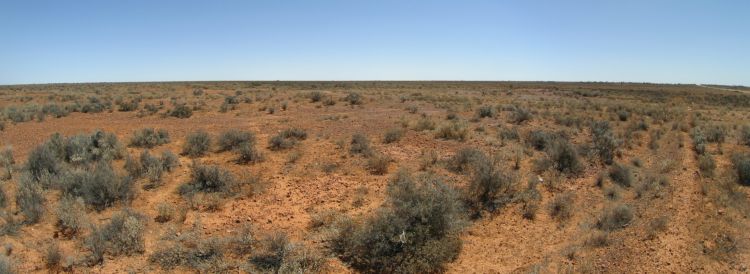
160 degree view of our observing site, looking southwest.

Looking northeast. The white dots on the horizon at far right are in the designated viewing area.
We were near the eastern extent of the Nullarbor, there were no trees. The only animals around were dead (roadkill) kangaroos. There were roo bones laying all over the place. The weather was a mixed bag: there were no clouds whatsoever, but there was a strong gusty wind that wreaked havoc on my equipment. In the animation further down you can see the scope bouncing around from the wind.
|
Here's a rundown of the equipment I had going:
- Canon D60 digital SLR with 100-400mm lens at 400mm F5.6, with a 1.4x teleconverter (for an effective 560mm F8, equivalent to 900mm on a 35mm camera). Used for partial phases and corona.
- Canon G1 digicam afocally coupled to a cheapo 80mm F5 achro refractor, with a 2x barlow and cheapo 25mm eyepiece. It was set to continuously take pictures (I duct-taped the shutter button down!). Used for diamond rings, chromosphere, and prominences.
- Sony Digital8 video camera at 25x, for video of Baily's Beads.
- Canon Rebel G film SLR with 8mm circular fisheye (not pictured), with ISO200 Fuji Superia film, program exposure mode. Used for all-sky photos of eclipse. This was my only film camera.
Everything but the Rebel was riding on my Meade LXD55 equatorial mount. We had about 80kg (180lb) of luggage, two checked bags and two carryons, managing to avoid any excess baggage fees.
The D60 and Rebel were controlled by my laptop, using software I hastily wrote and a relay box I designed. Early on I realized that I could either watch the eclipse visually, or take pictures of it manually, but not do both because the eclipse was so short. This automation setup allowed me to get specific exposures at specific times with no manual intervention, letting me get both pictures and visual observing in! Sorry, but I will not be releasing my software to anyone, it's too unrefined.
[Update: After several generations of development, this software is now known as Eclipse Orchestrator and is in use by eclipse chasers world wide! Surprisingly, the main screen design has withstood the test of time.]
|

|
Partial Phases
First contact is the time when the Moon begins to cover up the Sun, ever so slightly. The Moon then moved further across the Sun, obscuring more and blocking out sunspots.
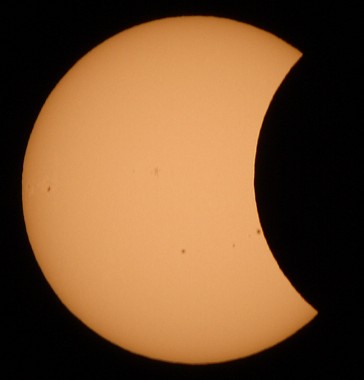
Ray (on the left) talked everyone into wearing eyepatches, which can give a better view of the corona (if you remember to remove it during totality!).
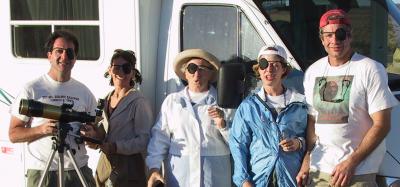
Yo Ho, Yo Ho, A Pirate's Life For Me!
The time from first to second contacts went by unbelievably fast. There was only about an hour between first and second contacts, but it felt like 10 minutes. This is an animation of the various phases from first to third contacts:

Below, just a sliver of Sun's photosphere is left in the seconds before second contact and totality (I can just hear the veteran eclipse chasers yelling at their computer screen "TAKE THAT FILTER OFF!!!")

Totality
In no time at all, it was second contact, when the Moon begins to completely cover the Sun. In all of the excitement I almost forgot to remove the filters from my cameras, finishing the task only five seconds before totality! Below is a crude animation of second and third contacts, showing the impressive Baily's Beads that we saw. You can also see the wind blowing the telescope around. (Note: mideclipse has been cut out, and this view is rotated 90 degrees clockwise compared to the other images which have North up.)

My video (with sound) of totality is available in these formats:
Click here for a better quality MP3 audio recording of totality (678kB, 58 seconds). You can hear me call out "Diamond Ring!"
We saw the Moon's shadow coming in just before second contact, slightly to the left of the Sun. The fisheye view below was taken a few seconds after second contact and shows the shadow near the bottom (look for the darkened sky just above the horizon; the white dot is the Sun). That's me with the binoculars in the upper right. A fisheye distorts the image, curving perspective to fit the whole sky in. Not a cloud in the sky...

Below is a shot of the prominences just after second contact. The prominences (red "flames") weren't very big, I had been hoping for something more impressive. We saw the prominences even before FIRST contact, thanks to Ray and his H-alpha scope!

Corona (the whitish wispy streamers) was visible past three solar radii through binoculars, and my camera captured streamers out to 3.6 radii (where the streamer went out of frame). Below is my composite photo of totality, carefully processed to match the view through my binoculars as I remember it. It is a composite of six images: five from the D60 digital SLR (for corona, exposures from 1/500 to 8 seconds) and one from the G1 (for prominences). This composite involved about 12 hours of work over three days. To see what a single exposure from the D60 looks like, the 1/60 second exposure is available here (processed to show corona) or here (straight out of the camera).
Below, my D60 camera just barely managed to capture a rare sight: the Moon's surface, illuminated by Earthshine. The view during the eclipse is at left, with a view of a typical full moon at right (with the same orientation and scale) so you can compare features.
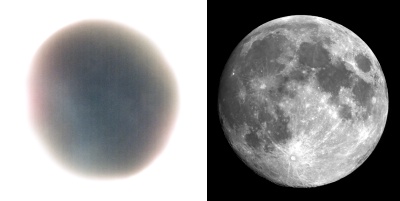
The eclipse went FAST. Africa 2001 felt like 5 seconds, but this felt like 2 seconds! I barely had time to take in the view naked-eye and through binoculars before it was over and the third contact diamond ring appeared, followed by some amazing beads (this is a still from my video camera).

After third contact, we turned around and saw the narrow shadow race up and away. Nobody in the group noticed any shadow bands, although to be honest we forgot to look for them. From first to third contact, the temperature dropped around ten or fifteen degrees F, enough to make people grab their jackets. Just after third contact the temperature was 71 degrees F.
For this eclipse and location, the Moon was only slightly bigger than the Sun, giving us a short totality (about 28.2 seconds). This seems short but I think it made the eclipse better: we got an outstanding view of Baily's Beads at 2nd and 3rd contacts, and we could see the prominences very well through the whole eclipse. (In a longer eclipse prominences and beads aren't visible for as long on centerline). Total eclipses that are only a few seconds in duration are definitely worth seeing.
Sunset
After third contact, we swapped our impressions, realized the mistakes we had made (bumping focus, leaving a cap on a binocular, forgetting to change film), and looked over the pictures I had just taken (aren't digital cameras wonderful!) We then kept watching the Sun as it set, with the Moon slowly pulling away...
We didn't see any green flash visually at sunset. Goodbye, Saros 142, see you in South America in 2020!

We stayed long after sunset to enjoy the exceptionally dark skies. It seemed like twilight lasted a very long time, although I now wonder if I was seeing the Zodiacal Light. This 24 minute time exposure (a stack of 2 minute exposures) was taken the night before in Glendambo with my 8mm fisheye lens and D60 camera.
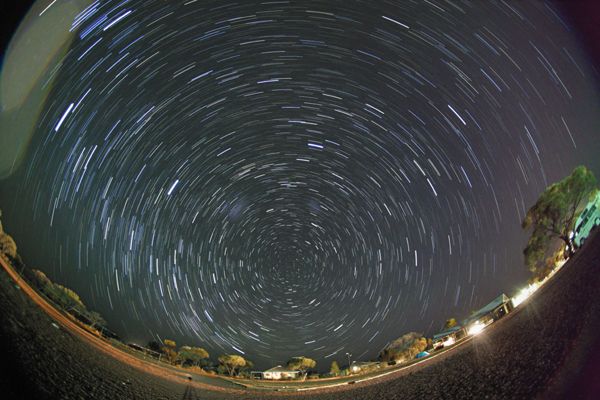
A few of us (myself included) noticed that we didn't experience any post-eclipse depression. Despite only 28 seconds of totality, this eclipse was definitely worth seeing. I can't wait for the next total eclipse, which will be over Antarctica. I plan to chase it from a plane, because I can't afford the time or money to see it from land or sea.
Full Trip Report
We also visited the Great Barrier Reef, and various sights around Adelaide. Click here for some first look photos. The full report will take several more weeks to assemble.
Other Eclipses
Solar eclipses I have seen:
- July 11, 1991 total: Saw partial phases from Colorado. It darkened a little.
- January 4, 1992 sunset annular: Watched on a hill a few minutes from my house in San Diego, which was in the path of refracted annularity. My pictures did not come out, but this sunset annular was impressive.
- May 10, 1994 annular: Clouded out in San Diego, which would have had a deep partial. It got pretty dark, so sometimes I count this one.
- December 25, 2000 partial: Saw, got pictures of partial phase. Was in San Diego, so only saw a small nick taken out of the Sun. Yawn.
- June 21, 2001 total: Saw totality from near centerline at Landless Corner Zambia. Spectacular!
- December 14, 2001 annular: Saw 22% partial phase from San Diego, CA.
- June 10, 2002 sunset annular: Saw 89% partial from near Puerto Vallarta, Mexico, was clouded out of the annular phase. I was positioned on centerline.
- December 4, 2002 total: Saw 28 seconds of totality at centerline on the Stuart Highway in South Australia. Spectacular!
Total time in totality: 4 minutes 2 seconds.
Recommended Links
- Mr. Eclipse - Eclipse predictions, maps, photography tips, etc. by Fred Espenak.
- Astronomical Tours - Astronomical Tours, highly recommended for eclipse chasing.
- Jay Anderson - Eclipse weather predictions.
Please visit my main astronomy page, or check out my homepage.
Comments? Questions? Click here to send email to me, Fred Bruenjes.
All text and images are © 2002 Manfred Bruenjes - All Rights Reserved. Framing and image inlining is strictly prohibited. Email for permission before using an image or text.




















